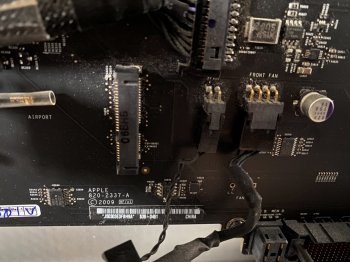Hi,
I have a problem with my Mac Pro 5.1 and I though maybe one of you could help me resolve the issue. I'll try to give as much detail as I can on what is going on.
First, I the problem occurred when the tip of a lightning connector (connected on one of the front USB ports) accidentally touched one of the Firewire port (also on the front panel). When this happened, my USB devices were shut down.
I have the unplugged the computer and waited about 1 minute. When I plugged back the computer, it tried to power on without success, and kept trying over and over again (see video)
The red DSI510 Led keeps flashing because the computer continuously restarting its power cycle.
Here's what I tried to fix this issue :
- Replace the PSU -- nothing changes
- Disconnect the front USB extension panel -- computer still powers on and I can't
- Clean fans, heatsink and case interior for dust
- I tried disconnecting all devices (hdds, GPUs, PCIe cards, etc) - When I try this, the computer gets through its power cycle and seems to start propertly. However when I press the power button to shut it down, it won't turn on again. I had to disconnect the power cable, remove the CR2032 battery and replace it. When I do so, the computer restarts. Then, when I add any component, I get the repeating power cycle issue.
Is there something I am missing ?
Any help would be greatly appreciated
Thanks,
I have a problem with my Mac Pro 5.1 and I though maybe one of you could help me resolve the issue. I'll try to give as much detail as I can on what is going on.
First, I the problem occurred when the tip of a lightning connector (connected on one of the front USB ports) accidentally touched one of the Firewire port (also on the front panel). When this happened, my USB devices were shut down.
I have the unplugged the computer and waited about 1 minute. When I plugged back the computer, it tried to power on without success, and kept trying over and over again (see video)
The red DSI510 Led keeps flashing because the computer continuously restarting its power cycle.
Here's what I tried to fix this issue :
- Replace the PSU -- nothing changes
- Disconnect the front USB extension panel -- computer still powers on and I can't
- Clean fans, heatsink and case interior for dust
- I tried disconnecting all devices (hdds, GPUs, PCIe cards, etc) - When I try this, the computer gets through its power cycle and seems to start propertly. However when I press the power button to shut it down, it won't turn on again. I had to disconnect the power cable, remove the CR2032 battery and replace it. When I do so, the computer restarts. Then, when I add any component, I get the repeating power cycle issue.
Is there something I am missing ?
Any help would be greatly appreciated
Thanks,



